Memorial Lecture: XXVII Dr. R. Raghavendra Rao G.B. Pant National Institute of Himalayan Environment (An Autonomous Institute of Ministry of Environment, Forest and Climate Change, Govt. of India) Kosi-Katarmal, Almora, 263 643, Uttarakhand, India
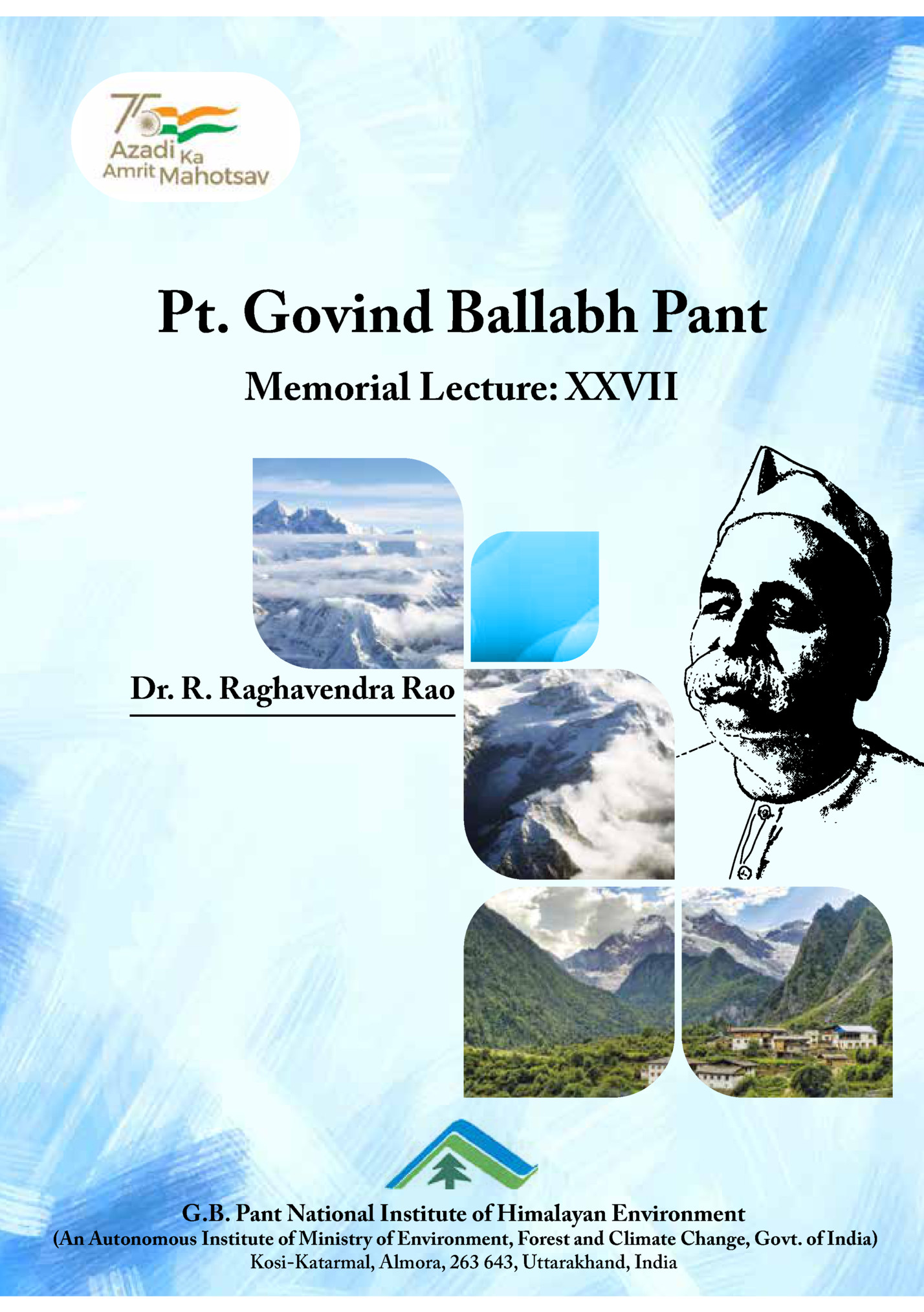
• • • • • • • • • • Fellow, Indian National Science Academy, New Delhi Fellow, National Academy of Sciences, Allahabad Fellow, Indian Academy of Sciences, Bangalore Fellow, Linnean Society of London, United Kingdom Fellow, Society of Ethnobotanists, Lucknow Fellow, Indian Botanical Society Fellow, Indian Association of Angiosperm Taxonomy, Calicut Fellow, Association for Plant Taxonomy, Calcutta Indian National Science Academy Honorary Scientist Chairman, Karnataka State Environmental Appraisal Committee Specialization: • Plant Taxonomy and Ethnobotany • Phytogeography, Medicinal & Aromatic Plants • Biodiversity and Conservation Awards & Recognitions: 2013 2008 2006 2001 1999 1999 Prof. V. Puri Memorial Medal, Indian Science Congress Association Calcutta, India Prof. Y. D. Tyagi Gold Medal of the Indian Association for Angiosperm Taxonomy, Calicut, India Elected President, Indian Botanical Society Scientist of the Year, National Environmental Science Academy, New Delhi, India Prof. B. A. Razi Medal of the Association of Plant Taxonomy, Calcutta, India Pitambar Pant National Environment Fellowship Award by Ministry of Environment and Forest, GoI 1994 William Harshberger Medal by Society of Ethnobotanists, Lucknow, India 1988-91 Elected President of Society of Ethnobotanist, Lucknow, India Research and Development Experience: • Dr. Rao did his B. Sc. in 1967 and M. Sc. (Botany) in 1969 from Mysore University, and Ph.D. in Systematic Botany from Mysore University, Manasa Gangotri, during 1974. He has spent almost 40 years in basic research, and around 34 years on surveying of natural resources. He has guided more than 30 candidates on basic research and produced 14 Ph.D. Dr. Rao has published around 240 research articles and 14 scientific books. • Dr. Rao has carried out research on various aspects of plant biology in North-East Hill University as Associate Professor, Botanical Survey of India at Kolkata & Dehra Dun as a Joint Director, and in NBRI and CSIR-CIMAP, Bengaluru, as Director-Grade Scientist. • Dr. Rao has served as the Editor of the International Journal of Ethnobotany (published by the Society of Ethnobotanists) and published 7 volumes of the journal during 1989-96. In addition, 3 volumes of Flora of India were also edited and published by him while working in Botanical Survey of India. Dr. Rao edited the departmental Journal, ‘Magnolia’ and brought out 5 volumes during 1975-79 during his stay at the North-East Hill University. He is currently serving as Member of Editorial Board of International Journal Herba Polonica, Poland. • Considering the immense contributions of Dr. Rao in plant Taxonomy, eight new taxa are named after him, and currently, Dr. Rao is engaged in teaching, research, research supervision, and serving various national level scientific committees of DST, DBT, DoEN of GoI.

Memorial Lecture: XXVII Dr. R. Raghavendra Rao September 10, 2021 at Kosi-Katarmal, Almora G.B. Pant National Institute of Himalayan Environment (An Autonomous Institute of Ministry of Environment, Forest and Climate Change, Govt. of India) Kosi-Katarmal, Almora, 263 643, Uttarakhand, India

Concerns & Strategies Dr. R.R. Rao Indian National Science Academy Honorary Scientist No. 328, B-4, Kendriya Vihar, Yelahanka, Bengaluru- 560064 Email.: raocimap@gmail.com Extended Summary Honorable dignitaries, Director and faculty of the Institute, ladies and gentlemen, It is indeed a great honour for me to deliver this memorial lecture named after Pandit Govind Ballabh Pant, a true son of the mountains is always remembered as one of the country’s most prominent freedom fighters and an administrator who played a key role in shaping modern India, actively took part in the Non-cooperation movement, the Civil Disobedience movement and the Satyagraha movement. He was the First Chief Minister of Uttar Pradesh (1946 -1954) and Union Home Minister (1955 - 1961) and was a recipient of the highest civilian award, the Bharat Ratna in 1957. He was a great Parliamentarian, a great thinker, and above all a great human being always struggled for the welfare of the people of Himalayan region. The Nation has given rich tributes to him by establishing the G.B. Pant University of Agriculture & Technology, Pant Nagar, G.B. Pant Institute of Engineering & Technology, Pauri, and our G.B. Pant National Institute of Himalayan Environment, Kosi, Katarmal, Almora. I feel proud to be associated with this unique Memorial lecture named after 1 Pandit G.B. Pant. I thank the Director and staff of the Institute for giving me this great opportunity. G. B. Pant National Institute of Himalayan Environment (Formerly known as G.B. Pant Institute of Himalayan Environment & Development) was established during 1988-89 as an Autonomous Institute of the Ministry of Environment, Forest & Climate Change (MoEF&CC), Govt. of India. I have been in close association with this Institute since the time of land selection for this Institute. During the last three decades, the Institute has made commendable progress and achievements in evolving integrated management strategies for conservation of natural resources, and to ensure environmentally sound development in the entire Indian Himalayan Region (IHR). All the Directors and the faculty have greatly contributed to the Institute that is what is today. While remembering the contributions of all Directors of the Institute, I also wish to express my condolences for the recently demised Directors, Dr. R.S. Rawal and Dr. U. Dhar. The Himalayas are the world’s loftiest but youngest mountain ranges extending for over 2500 km from south of the Indus
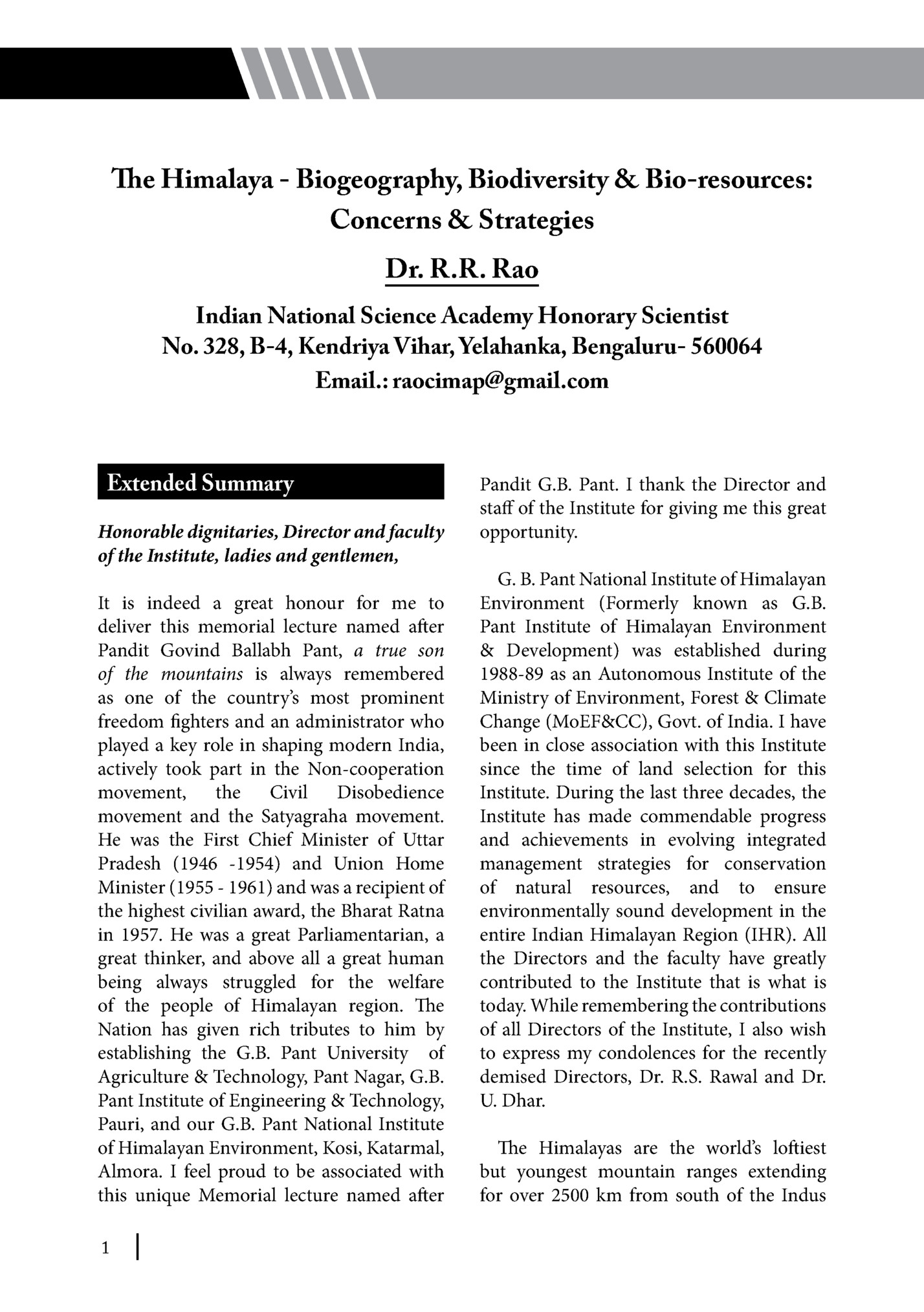
m) in the west to Namcha Barwa (height 7755 m) in the east between 720 and 910 E and 360 N. The width of the Himalayas from south to north varies between 200 and 350 km. The altitude ranges from 300 m to 8849 m. Of the more than 110 peaks rising to elevations of 24,000 feet (7,300 m.), Mt. Everest is the world’s highest, with an elevation of 8,849 m. The Himalayas evolved some 70 million years ago, during Upper cretaceous period due to Indo-Australian plate colliding with Eurasian plate (plate tectonics theory). It is presumed that the Indo-Australian plate is still moving at 67 mm/year resulting the Himalayas rising by about 5 mm/year, making them geologically active experiencing a high number of earthquakes and tremors. With the hitting of Indo-Australian Plate with Eurasian Plate, the Himalayas erupted by a gradual process of “Corrugation” from the hypothetical Tethys sea bed, the residue of which is Mediterranean Sea. Occurrence of sea fossils even on Mt. Everest is supportive of this view. Such weaker areas in continental landmass are geologically termed “faults”- sensitive areas for Earthquakes. The Himalayas are bordered to the northwest by the mountain ranges of the Hindu Kush and the Karakorum and to the north by the high and vast Plateau of Tibet. The Himalayan ranges are formed of four parallel longitudinal mountain belts. They are designated, from south to north, as the Outer or sub Himalayas (also called the Siwalik Range); the Lesser Himalayas; the Great Himalayas and the Tibetan Himalayas. Farther north lie the Trans-Himalayas or the Cold Deserts. The climatic conditions and the floristic composition in the Himalaya are so varied that different bio-geographers have divided the Himalayan systems into three to four of five divisions (Clarke, 1889; Hooker, 1906; Chatterjee, 1940, 1962; Mani, 1974; Rodgers & Panwar, 1988). For the present discussion, I consider 3 regions namely, the West Himalaya (J & K; H. P.; Garhwal & Kumaon region), the East Himalaya (Arunachal Pradesh, Bhutan, Sikkim, Darjeeling district of West Bengal) and the Central Himalaya (Nepal). West Himalaya covers areas west of western Kumaon and differs from East Himalaya in greater breadth and length, higher altitude, scanty rainfall, heavy snowfall, cool and dry climate. The tree line in West Himalaya ca. 3600 m whereas in East Himalaya it is at 4600 m (beyond tree line is alpine zone). Above 5400 m is permanent snow. The Phyto-geographical affinities of the Himalayan flora have been discussed by several workers (Meher-Homji, 1965; Gupta, 1962, 1964, 1982; Kanai, 1963; Hajra & Rao, 1990). It is well established that the European and Central Asian elements are frequent in areas west of the river Sutlej, while the Chinese elements extend from Yunnan in the east right through the East Himalayan ranges. In fact, the Himalayas have drawn floral elements from Mediterranean, IranoTuranian, north African, Siberian and in the east Chinese and Malaysian elements. The present day Himalayan flora is related to the flora of northwestern and western China in the eastern sector while the Mediterranean elements become more numerous westward from Sikkim to Kashmir through Nepal, Kumaon and Garhwal region including Nanda Devi Biosphere Reserve. Temperate floristic elements are too many in Himalayas. Some of the conspicuous temperate elements in the Flora are Anemone, Clematis, Thalictrum, Ranunculus, Caltha, Callianthemum, Sambucus, Trollius, Isopyrum, Aquilegia, Delphinium, 2
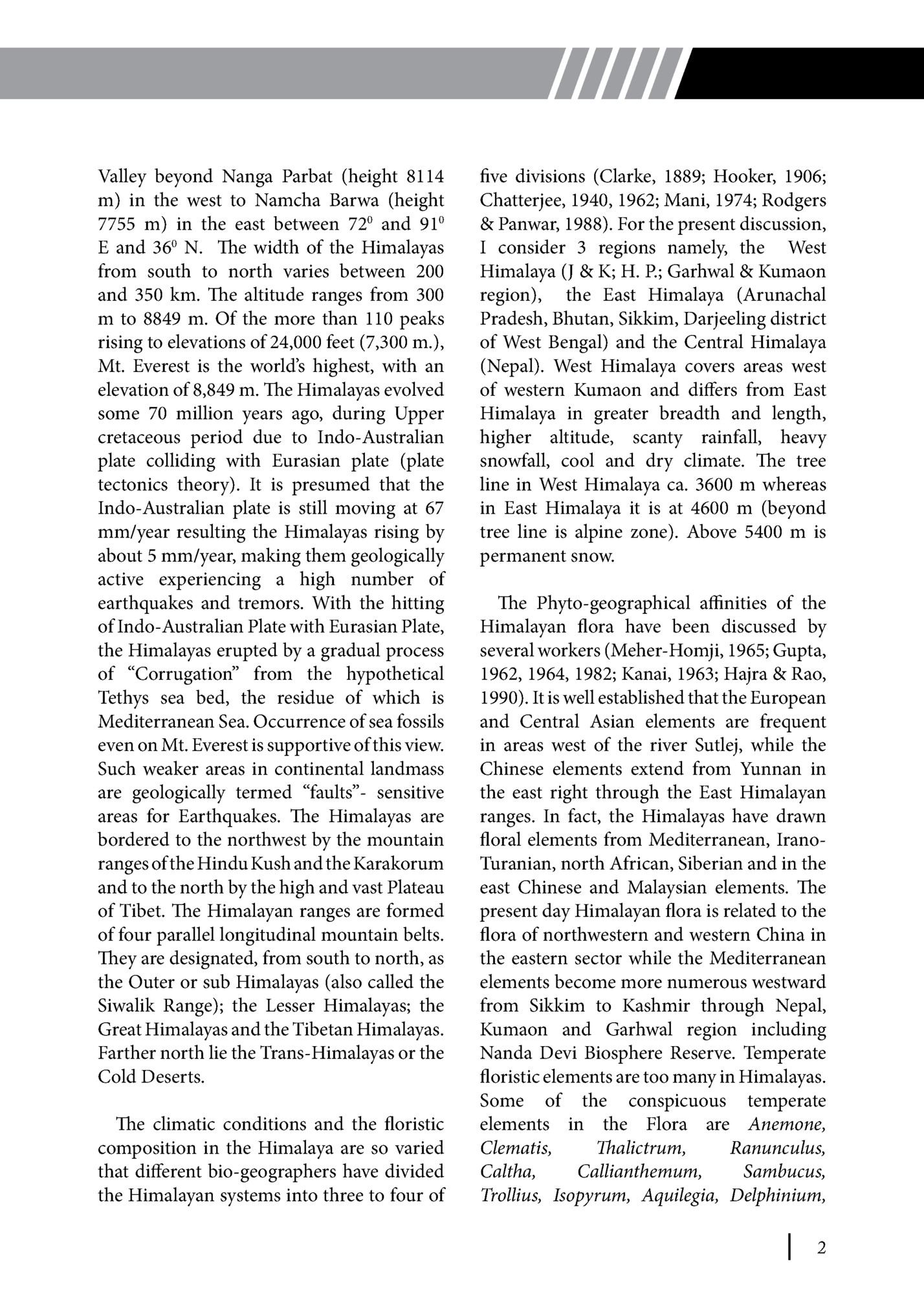
Paeonia, Berberis, Viola, Epimedium, Corydalis, Erigeron, Aster, Fumaria, Silene, Thermopsis, Trifolium, Oxytropis, Fragaria, Senecio, Saussurea, Lespedeza, Galium, Asperula, Valeriana, Brachyaster, Achillea, Tanacetum, Leontopodium, Anaphalis, Crepis, Taraxacum, Androsace, Lysimachia, Cichorium, Picris, Lithospermum, Arnebia, Pedicularis, Mentha, Thymus, Geum, Myosotis, Calamintha, Dracocephalum, Teucrium, Cheiranthus, Arabis, Parrya, Cardamine, Draba, Cochlearia, Eutrema, Braya, Saxifraga, Dianthus, Gypsophila, Cerastium, Arenaria, Parnassia, Stellaria, Agrimonia, Potentilla, Pleurospermum, Circaea and Epilobium. Similarly, the dominant Mediterranean floristic elements in the Himalaya are Fagonia, Argyrolobium, Ononis, Eruca, Trifolium, Moricandia, Nerium, Ziziphus, Capsella, Chorispora, Trigonella, Eryngium, Celtis, Malcomia, Melilotus, Medicago, Colutea, Quercus, Viburnum, Cotinus, Alhagi, Hypecoum, Prosopis, Fraxinus, Prunus, Papaver, Cedrus, Diplotaxis, Rosa, Punica, Farsetia, Alyssum and Pyracantha. The Steppe Elements like Megacarpaea, Eurotia, Axyris, Tauschia, Kochia, Euclidium, Morina, Cnicus, Perula, Hippophae, Guldenstaedtia, Myricaria, Astragalus, Juniperus, Scabiosa, Artemisia, Triplostegia, Eremurus, Dipsacus, Prangos and Hyoscyamus are dominant in W. Himalaya. The Tropical Asiatic Elements like Pittosporum, Phoebe, Saraca, Terminalia, Decaspermum, Oxyspora, Machilus, Litsea, Haldina, Uncaria, Hedyotis, Lasianthus, Eriobotrya, Kalanchoe, Willughbeia, Medinilla, Trachelospermum, Photinia, Gymnopetalum, Daphne, Pentanura, Pygeum, Myristica, Diospyros, Cinnamomum, Beilschmiedia and Jasminum are dominant 3 in East Himalaya at comparatively lower altitudes. There are also some genera of African origin and the occurrence of such plant genera in both Africa and India may be explained in one of two different ways - The genus may have a Gondwana origin; that is, it may have arisen before Africa and India got separated into distinct continents. What was once a contiguous range was broken into a widely disjunct distribution by continental drift; or the genus may be much younger, having arisen on one continent and subsequently established populations on the other by long-distance seed dispersal may be by migratory birds. The Chinese mountains being much older in age (300 million years) compared to Himalaya have contributed significantly to the Himalayan flora. It is believed that during Tertiary period a common flora covered the whole of East Asia including Himalaya, China and Japan. The successive changes in climate and topography during Pleistocene period resulted in the separation of floras as well as resulting in bringing new elements and pushing some existing elements causing isolation and disjunct distribution of several taxa such as Olea ferruginea, Berberis, Saxifraga, Monotropa, Polygala abyssinica, Micromeria biflora and the Cedars. Some taxa having discontinuous or disjunct distribution in Himalaya are listed. The Biogeography of Himalaya (distribution of floristic elements between West and East Himalaya) is quite fascinating but needs extensive and critical analysis of flora. The East Himalayan flora is more related to the Tropical humid SinoHimalayan and Malayan flora while the West Himalayan flora has affinities with Eurasian flora. Several species of Western
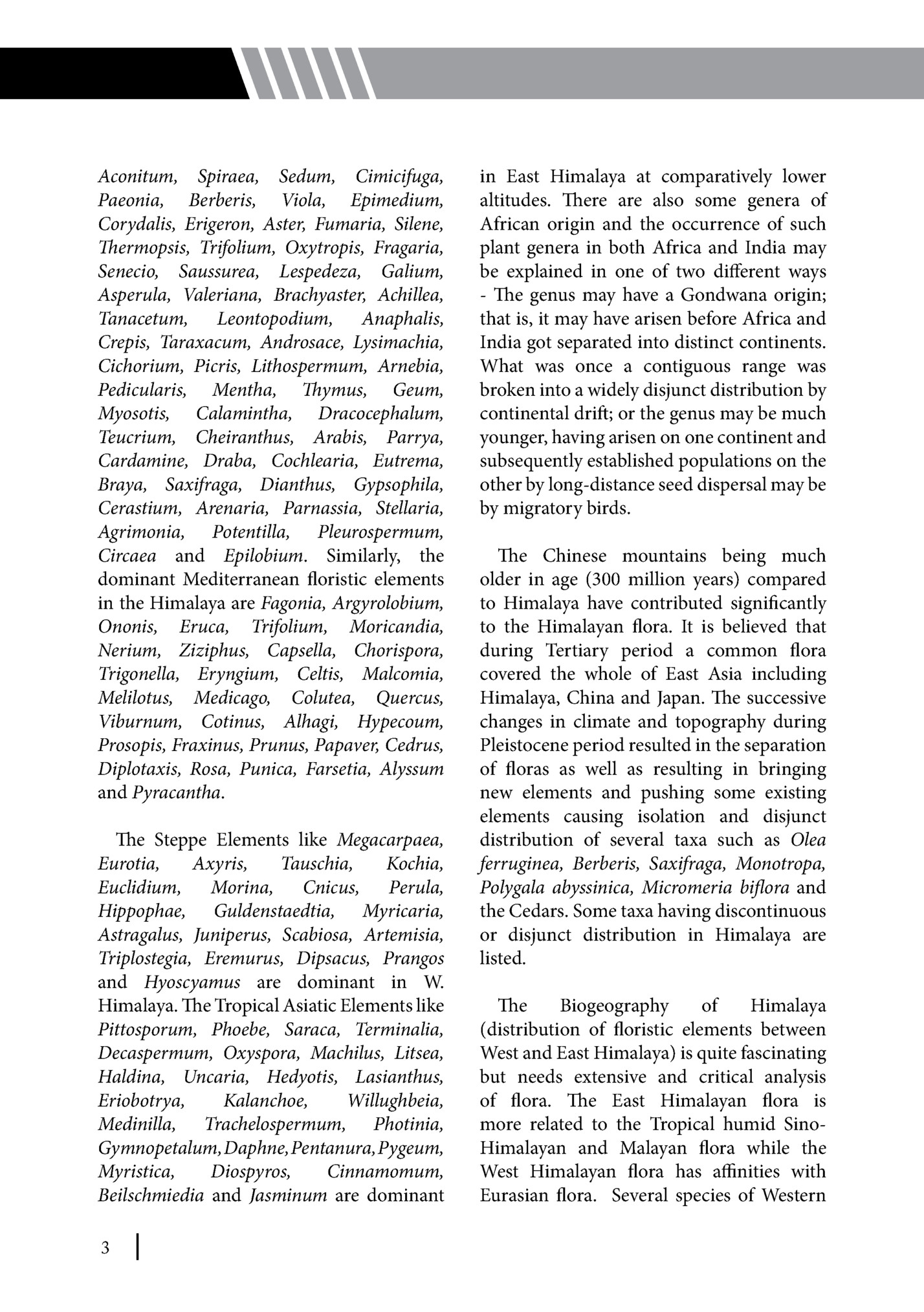
western border of Nepal but absent in E. Himalaya, i.e. Pinus gerardiana, Juniperus macropoda and Picea smithiana. The Steppe elements like Artemisia, Chenopodiaceae members, Juniperus semiglobosa and J. turkestanica are recorded from Nanga Parbat region. The species like occur in E. Himalaya but absent beyond E. Nepal. Again, Cedrus deodara distributed from Afghanistan to W. Himalaya extends to western Nepal and absent beyond this limit. Primula sikkimensis, Magnolia campbelli, many orchids, Rhododendrons and some palms of Eastern Himalaya extend their westward distribution as far as Kumaon. Therefore, the area east of Kumaon and west of Nepal between 830 and 840 E is a transition zone between the West and East Himalayan phytogeographic regions (Stearn, 1960), and still needs intensive and critical phytogeographic analysis. Regarding Gymnosperms as far as the number of species are concerned although Eastern Himalaya are far richer, there exist vast coniferous forests in the western Himalaya. Pinus gerardiana, Juniperus macropoda and Picea smithiana are some gymnosperms distributed in the northwest Himalaya but are absent in the eastern Himalaya. Similarly, the genus Ephedra is well represented in Western Himalaya with six species while only one species, Ephedra gerardiana (somalata ?) occurs in East Himalaya. On the other side, several species like Larix griffithiana, Picea spinulosa, Cephalotaxus griffithii, Gnetum montanum, Cycas pectinata and a few others found in east Himalaya are absent beyond east Nepal. The forest types in Himalaya are so numerous and diverse that only some broad vegetation types can be outlined. The forests of the Himalaya are broadly classified as (1) the Montane tropical and subtropical forests up to elevation of 1200 m, (2) the Montane temperate vegetation from about 1700 to 2000-2500 m, and (3) the alpine vegetation stretching from 3000 to 4500 m. Depending upon the local climate, numerous subtypes of these forests have also developed. At the basal region of extreme western end, the vegetation is semi-arid with bushes of Capparis, Calotropis and Stipa. Subtropical conifer forests mostly of Pinus roxburghii (chir pine) often in pure formation occur in West Himalaya and P. khasiana in East Himalaya (often mixed with some broad leaved trees) are noticed at lower altitudes while the temperate conifer forests of Abies, Cedrus, Picea and Taxus at higher altitudes stretching from 3000 to 3500 m in West Himalaya are common. The wet temperate broad leaved forest around 2500–3000 m includes several typical temperate species like Quercus, Rhododendron, Engelhardtia, Castanopsis, etc., in moist areas. In the semi arid cold desert region of Ladakh and Lahaul-Spiti many stunted, cushion forming and gnarled shrubs of Juniperus, Stachys tibetica, Caragana versicolor, Acantholimon lycopodioides, Thylacospermum caespitosum and Hippophae rhamnoides are common. The alpine zone in the Himalaya, particularly west Himalaya is the most fascinating feature of vegetation with enormous floral diversity. The alpine zone begins above the tree line, between elevations of 3,200 and 3,600 m. extending up to about 4,200 m in the west Himalaya and up to 4,500 m or more in the eastern Himalaya. The alpine vegetation of Aconitum, Aquilegia, Astragalus, Cotoneaster, Rhododendron, Potentilla, Primula, Saxifraga and several genera of Asteraceae are remarkable. Juniper (genus Juniperus) is widespread, especially on sunny sites, steep and rocky 4
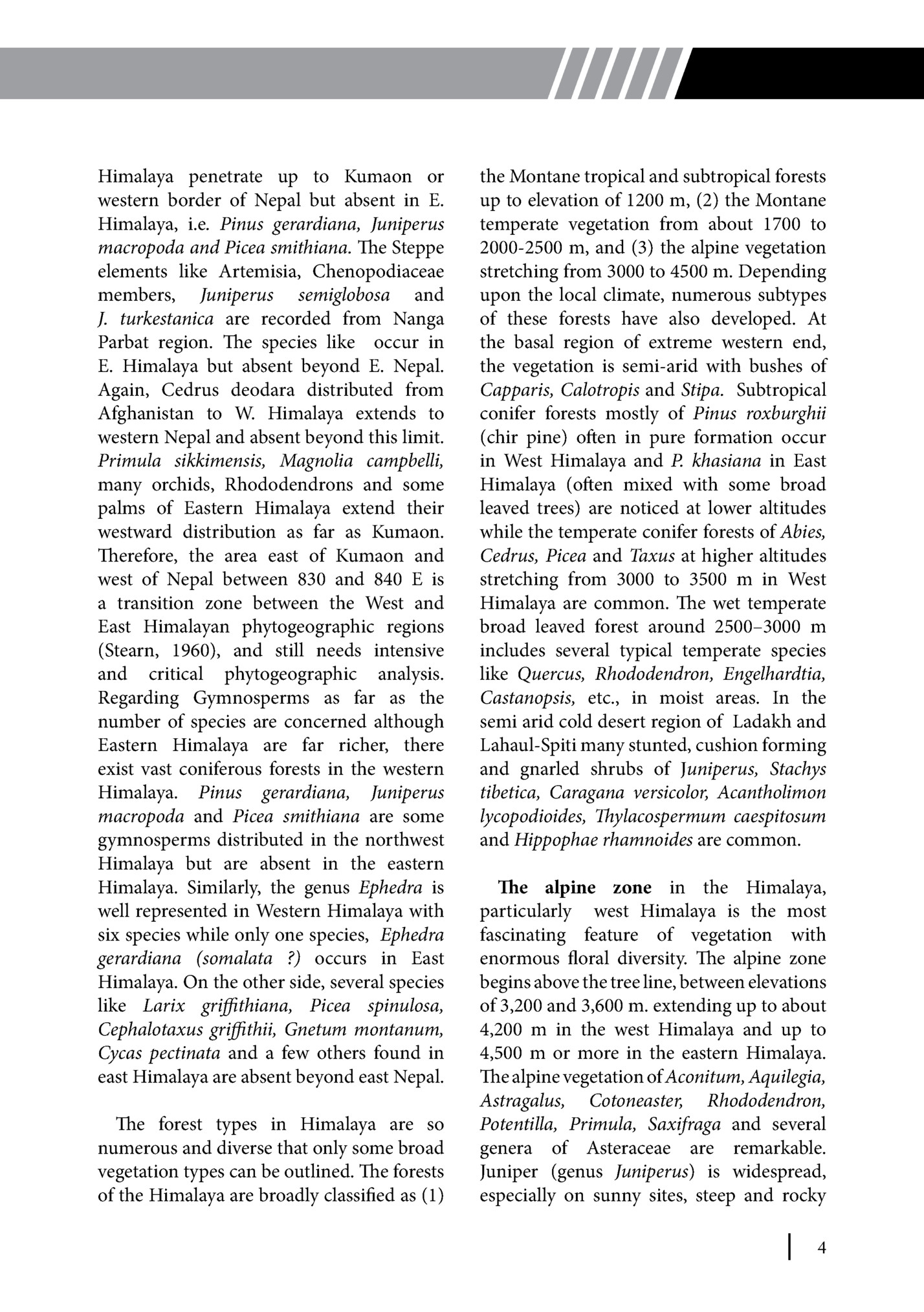
occurs scattered but is more abundant and conspicuous in the wetter parts of the eastern Himalaya. The mosses and lichens grow in shaded areas at lower levels in the alpine zone where humidity is high. The alpine region is covered by heavy snow for almost 7-8 months in a year. The flora is mostly of herbaceous plants scattered in the meadows locally called Bugyals. Almost all the species are ephemerals - complete their life cycles in a week’s time or 10 days. The flowers are highly brightly coloured to attract the scarce insect population in the region. A kind of floral rhythm can be observed in the alpine flora. Different species comes to bloom at different times in succession at regular intervals. This adaptation is again to use the services of scarce pollinators. Almost all plants of a given species come to bloom (gregariously) simultaneously forming a carpet of different colours. Compared to the overall size of the plant the flowers are much larger and conspicuous, another adaptation of alpine plants to attract the pollinators. ‘The Valley of Flowers’ in Garhwal Himalaya is a typical Alpine flora and is considered as the botanical paradise in India. The sub-alpine zone in W. Himalaya is also of high altitude type and support a large number of floral and faunal communities. Many of the species of the alpine zone are also found here. The dominant species of the zone are the Himalayan maple Acer caesium, west Himalayan fir Abies pindrow, Himalayan white birch Betula utilis and Rhododendron campanulatum with Himalayan yew Taxus wallichiana, Syringa emodi and Sorbus lanata. Some of the common herbs are Arisaema jacquemontii, Boschniakia himalaica, Corydalis cashmeriana, Polemonium caerulium, Polygonum polystachyum, 5 Impatiens sulcata, Geranium wallichianum, Galium aparine, Morina longifolia, Inula grandiflora, Anemone rivularis, Pedicularis pectinata, P. bicornuta, Primula denticulata and Trillidium govanianum. Both alpine and sub alpine zones are sensitive to disturbance (fragile ecosystems). Floristic diversity: Thanks to numerous plant taxonomists, the flora and vegetation of the Himalayas are fairly well known. Yet, the botanical surveys in this region are inadequate or incomplete. This is evident by the fact that hundreds of new taxa in all groups of plants are being discovered and described almost every year. The floristic diversity in the Himalaya is so rich and diverse that it is not possible to discuss in its entirety here nor it is required too. The Himalayas support a very rich biodiversity mainly due to the Strategic position having connection with adjacent rich floristic regions, vast stretch of geographic area, diverse habitats – dry deserts, cold deserts, alpine, temperate, tropical habitats, wetland areas, diverse ecological conditions (High rainfall area, coldest place on earth etc.), altitude varying from sea level to the highest mountain ranges of the world, Gondwana connection in the geologic past and the entire Himalaya forming an active speciation zone, where new species are being added regularly. The Himalayan bio-geographic zone is the richest and unique botanical region in India and encompasses a broad range of ecological habitats varying from grassy meadows to dense humid evergreen forests; disturbed secondary formations to almost virgin and relict types as in `Sacred Forests’. We find in this region a mixture of tropical, temperate and alpine forests each type depicting its own characteristic biodiversity. About 50% of total number of vascular plant species of India occur in this region which
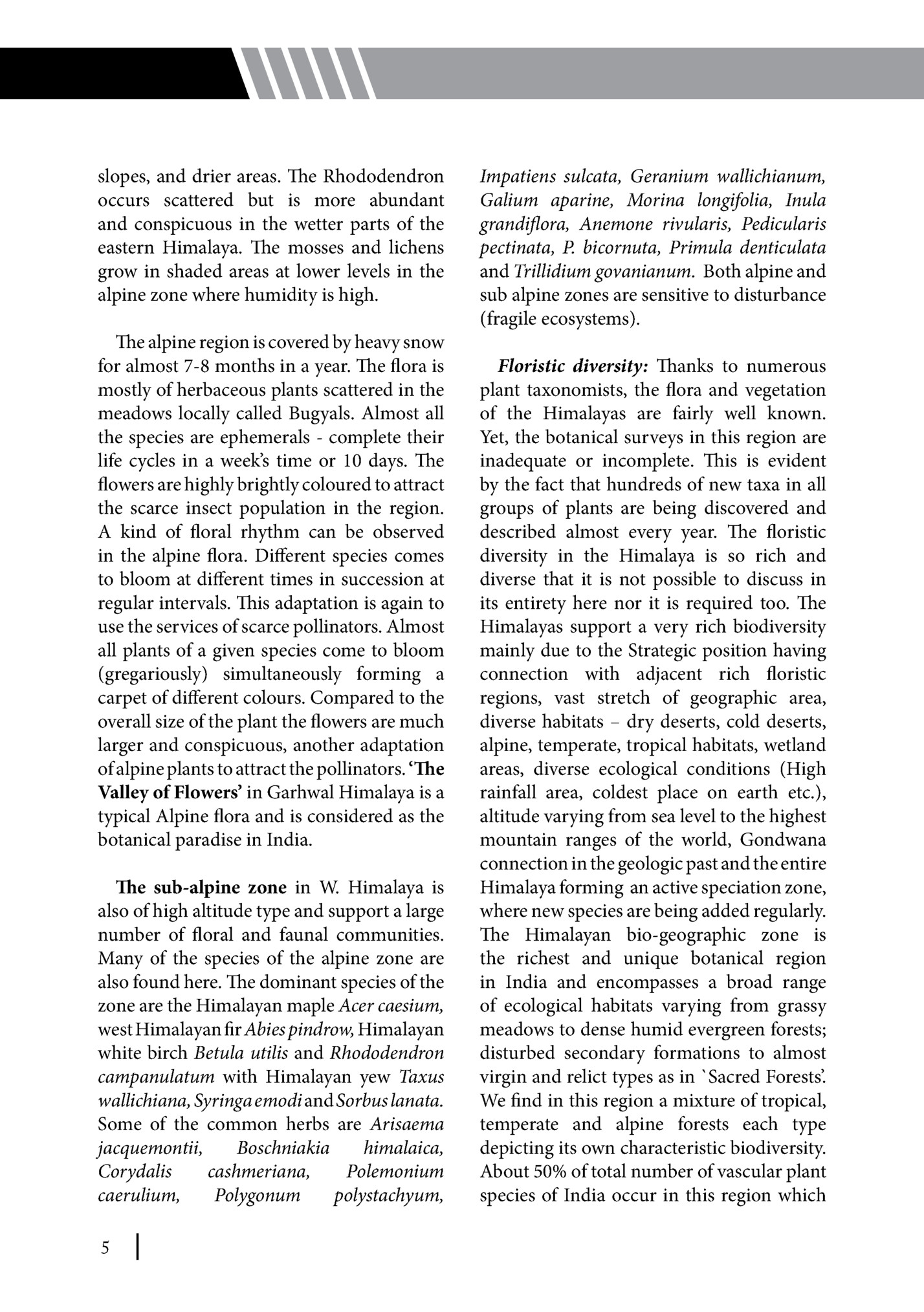
region being the `Sanctuary of Primitive Angiosperms’ is considered as the ‘Cradle of Flowering Plants’ where many groups of angiosperms have originated and diversified (Takhtajan, 1969; Rao, 1994). Regarding the diversity in terms of number of taxa a total of 8765 taxa comprising 1912 genera and 210 families are reported from Himalayas (although bio-diversity is not just the game of numbers). Among this, the J&K region has 1649 species, Himachal Pradesh 2558, Uttarakhand 3846, Arunachal Pradesh 4079 (5500?) species. Asteraceae, Orchidaceae, Poaceae and Fabaceae are the most dominant families each having 1390, 1370, 1060, 960 taxa, respectively. However, no infra specific diversity is assessed, although a high number of ecotypes or populations are expected in the different altitudinal ranges of Himalaya. Such infra specific diversity is most needed for medicinal plants for their sustainable utilization. Several families in the Himalaya show great floristic diversity both at species and infra specific level and are represented by more than 100 species. Some plants e.g. species of Christolea, Arenaria, Thylacospermum, Acantholimon, Festuca and Juniperus that occur especially in the high alpine meadows in cold desert regions of Trans-Himalaya survive the extreme adverse ecological conditions by special adaptations. Cushion forming plants include species of Androsace (Primulaceae), Saxifraga (Saxifragaceae), Rhodiola (Crassulaceae), Thylacospermum and Arenaria (Caryophyllaceae). Several hundred plants aggregate together to form a dense, spherical or globose cushionlike habit. Certainly this is an adaptation against severe cold and heavy snowfall during winters. One cushion of Arenaria or Thylacospermum measuring ca 30cm diam. takes as much as 100-150 years. Among the insectivorous plants Nepenthes khasiana, Drosera burmannii, D. peltata, Utricularia spp. are of significant interest. Christolea himalayensis is reported to be growing at 6300 m, which is the highest altitude known for a flowering plant in the world. On the other end of the spectrum there are some plants with unusual forms in the high alpine areas. These may be ‘cushion forming’ or ‘snow ball’ plants or the ‘hot house’ plants. The ‘snow ball’ plants, Saussurea gossypiphora and S. graminifolia (Asteraceae) look like a snow ball due to the dense, white woolly hairs which cover the entire plant and protect from cold wind and snow and keeps warm in day time even if outside temperature suddenly falls. Bees or flies take shelter in the warmth and at the same time pollinate the flowers. The dense woolly hairs that cover the apical meristem act as a sort of thermal insulation. There is yet, another interesting group of ‘hot house’ plants like the Rheum nobile and Saussurea obvallata which have their inflorescence sheltered by leafy bracts that can be compared to glasses of a ‘hot house’. The flowers open inside the bracts, where the insects also take shelter for warmth and at the same time pollinate the flowers. Endemism in the Himalayan Flora The Himalayan flora is an admixture of floras drawn from the adjacent countries and mountains. Still, a large number, in fact ca 30% of the Himalayan flora is more or less endemic. A vast majority of the endemics are neo-endemics having originated in the Himalayas in the recent past. According to Chatterjee (1940) the endemic dicots in the Himalayan flora (including Nepal & Bhutan) are 3169 and about 1000 monocots. This is certainly a high number for a continental 6
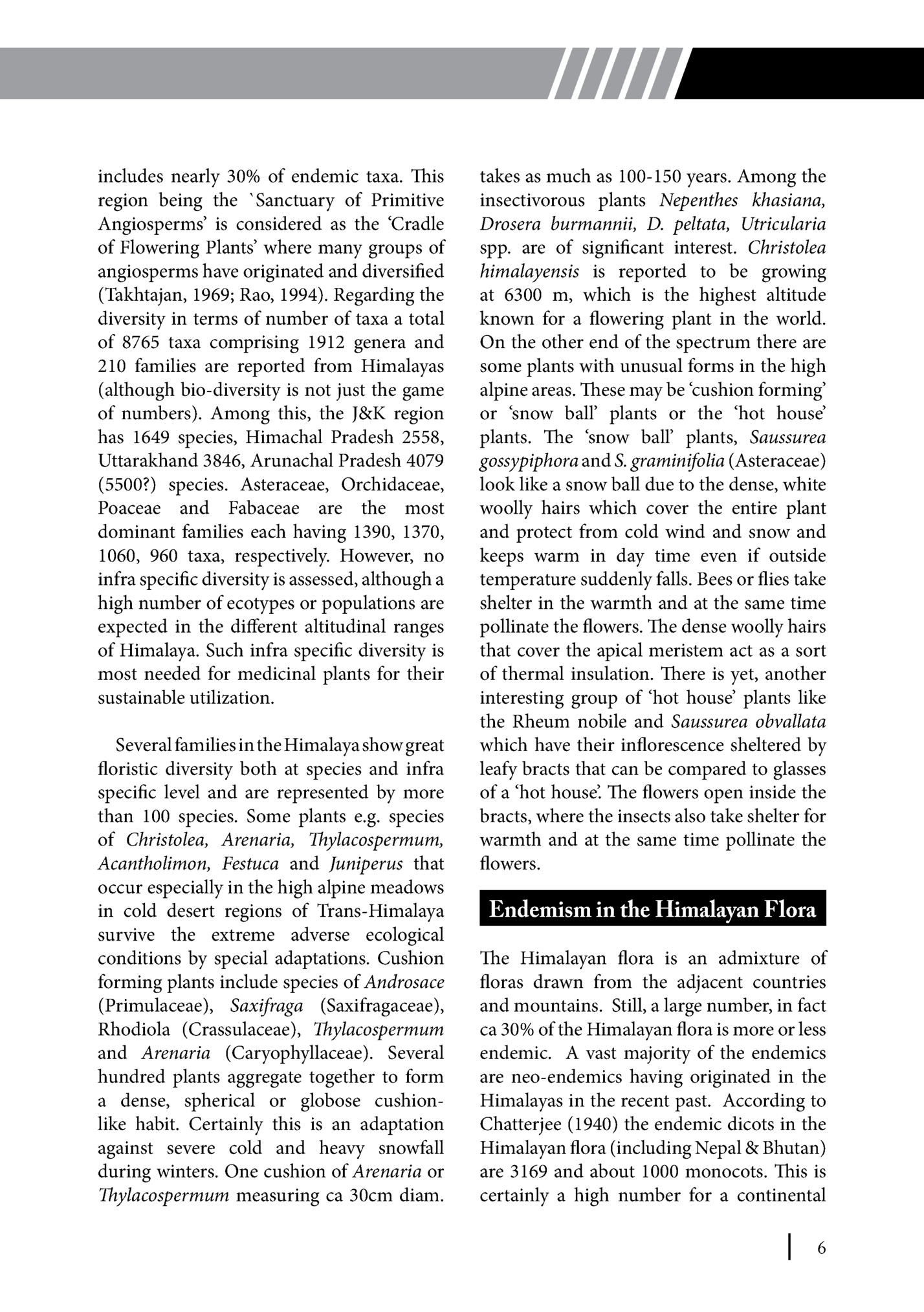
Fleepit Digital © 2021